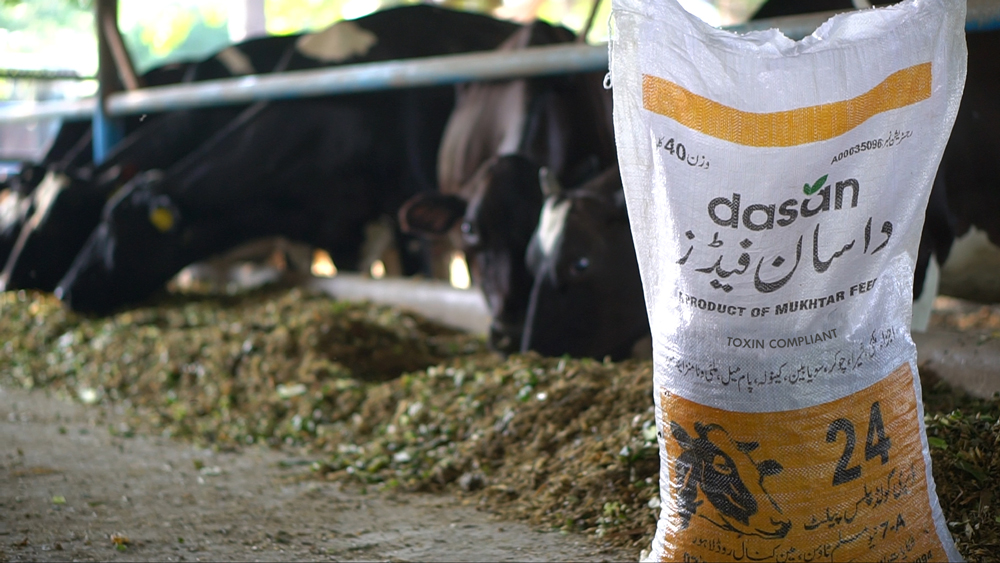HOW TO IMPROVE FEED INTAKE IN CATTLE DURING SUMMERS

Climate change with a constant raise in temperature, negatively effects the cattle production and health. This raise in temperature may cause heat stress in cattle which badly effects the production and reproduction of animals. There are nutritional modifications that can be made for improving feed intake during hot weather. Many of these changes are made to overcome the reduced dietary intake in cattle and to improve their health and milk production.
EFFECTS OF HOT WEATHER ON COWS
The normal body temperature of a cow is 101.5 degree Fahrenheit, when it exceeds the 77 degree Fahrenheit, cattle show the signs of heat stress. Following are the major indicators that shows cows suffering from heat stress:
- High body temperature
- High panting rate 80 per minute
- Reduction in feed intake
- Reduction in milk yield about 10 to 15%
- Reduced activity
During high temperatures and heat stress, cows show a drastic decrease in feed intake, it can be considered as preventive measure to reduce metabolic heat production. However, there are many factors which effect the extent of heat stress for the cattle, including;
- Size of cow
- Lactation stage
- Breed or color
- Cooling management
- Level of milk yield
- Quantity of feed consumed
- Environmental condition’s severity
These factors influence metabolic heat production, heat dissipation, and ultimately the degree of stress to which the cattle is subjected.
COOLING OR SHADING ADVANTAGES
Providing shade or cool environment has a positive impact on cows’ life during hot weather. It’s not only improve or help in their feed intake routine but also increases the milk production. More the cows will be comfortable and relax during hot times more will be the milk yield.
However, shade alone is not enough to provide full comfort to cows, an extra cooling system lie fans, air conditioners or water sprinkles should be added for this. It has been observed that providing proper comfort during hot times increases the feed intake of about 10-12% and milk yield from 8 to 5%.
However, shade alone is not enough to provide full comfort to cows, an extra cooling system lie fans, air conditioners or water sprinkles should be added for this. It has been observed that providing proper comfort during hot times increases the feed intake of about 10-12% and milk yield from 8 to 5%.
- Feed should be present all the time in the bunk so that it can be easily accessible by the cows whenever they need it.
- Keep an eye that feed should not be dry, hot, spoiled or smelly due to hot weather.
- There should be enough space for all the cows at feed bunk.
- The ration should be mixed well and consistent.
- Feed intake adaptation changes like more intake during night than day time.
- Add water if the ration feels enough dry for cows.
Forage and concentrates
Practical approaches are needed to maintain DMI (dry matter intake) as it is directly proportional to the energy taken, and for this purpose regular feeding with short interval, high quality forage, proper nutrition balance and pleasant diet needed. Because feed intake is reduced during hot weather thus it also reduce the nutrition and in result milk production. To avoid such things following are some simple and easy tips that help cows to eat more frequent and make the dairy producer more profits.
Dietary fat feed during summers
If we compare the amount of energy between carbohydrates and fats then it’s crystal clear that fats have 2.25 times more energy than carbohydrates. Fats are more preferable as dietary supplement when DMI is limited to cope the energy demand. Feeds with fats supplements has improved the fat-corrected milk yield during hot weather.
Crude Protein
It is a common observation that insufficient dietary protein intake can reduce the milk yield. An adequate amount of protein in needed in diet to improve the milk production, but excessive intake of protein may cause serious problems like it may impair reproductive performance. It has been observed that when cows were cool evaporatively, they were more responsive towards protein quality and intake, giving maximum milk yield. It has been concluded that for the best production cows should be cooled and their diets must be modified to compensate the effects of heat stress.
Mineral supplements
Mineral needs of cows changes during hot weather. They also sweat like other mammals but their sweat contains large amount of potassium (K) unlike humans who sweat more sodium (Na). due to which their requiement for potassium increases during summer, similarly they demand more sodium and magnesium during hot weather. Following are the ranges of minerals needed during heat stress:
- Potassium 1.4 – 1.6%
- Sodium 0.35 – 0.34%
- Magnesium 0.35%
Feed additives
In addition to formulating nutritional diets for cows, a number of “non-nutritive” additives are available, which have the capability to improve the performance of cows during summer. But one should know which cow will get benefits while using these additives as they are not suitable with every dietary supplement or for every breed as well. The most common additive used frequently is sodium bicarbonate that is especially useful during hot weather.
In short the best way to improve the feed intake of cows during hot days is to provide them cool shelter, plenty of water, less fibrous food and to change their feeding time more in early morning and evening and less during day time to avoid the milk production loss.
In short the best way to improve the feed intake of cows during hot days is to provide them cool shelter, plenty of water, less fibrous food and to change their feeding time more in early morning and evening and less during day time to avoid the milk production loss.
